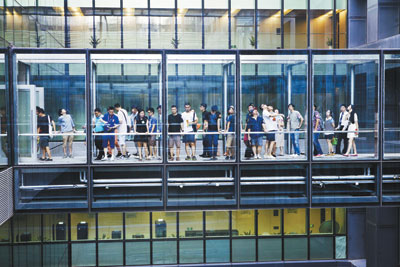|
Tan Yifan
cicitan2011@gmail.com
THE charm of Shenzhen for world-renowned architects is how it is open to all kinds of experiments, said a local architect surnamed Zhang at a recent forum held at Shenzhen Book City CBD Store.
Around 100 people, including famed designers and architects, attended the discussion about the newly completed Shenzhen Stock Exchange Building held by Shenzhen Center for Design. Liang Xiuzhi, staff member for the center and one of the leading organizers, said the forum was part of the seventh activity of a whole year’s worth of events designed to help local residents get closer to the city’s architectural masterpieces.
“Design and Life” is the yearlong initiative inviting citizens to meet local designers and artists and hear their viewpoints on architectural design and how it affects people’s daily lives.
“We were hoping to help ordinary people see that architects are not cold or distant, and we wanted to encourage dialogue between designers, architectural critics and everyone else,” said Song Li, another co-organizer from the center. “The events have far surpassed our expectations. Far more people have registered for and are attending the events than we expected, and there have been many heated discussions.”
The organizing team hosted guided tours of several of the city’s landmarks, including Nanshan Wedding Hall, the Shenzhen Concert Hall, the Shenzhen Library, Shenzhen University and the new headquarter for the Shenzhen Stock Exchange in Futian District.
The recent forum on OMA (Office for Metropolitan Architecture) design of the stock exchange building has generated many fascinating discussions.
Following an afternoon tour July 5 to the Shenzhen Stock Exchange Building on Shennan Boulevard, visitors, OMA’s designers, an architectural critic and a social critic attended the recent forum and shared their thoughts on the black, 254.8-meter-high skyscraper.
He Wanyu, one of OMA’s designers, introduced the main feature of the building’s appearance and the suspended base of the tower building.

“Designers usually add a base or a podium building to the tower building as a functional separation from the tower building. But when we were assigned the project, we wanted to provide more public space for people passing by,” He said. “Thus, we decided to suspend the base 36 meters high, which meant visitors could actually enter the base of building through the foot of the tower building. By doing so, people are invited inside the public area of the mysterious skyscraper.”
“The idea behind such a design is to create more usable public space in the city’s CBD,” He added. She also said that they designed a garden on the roof of the suspended podium with a 400-meter-long track. “Buildings should be humane,” she said. “It should be constantly moving and growing and should stimulate viewers’ imaginations.”
With a recessed façade wrapped with OMA’s special patterned glass, the building has a crystalline, changeable effect.
But some attendees pointed out that the building gives people a sense of coldness because of the dull color applied both inside and outside.
“It is a neat design that sets the tone for the future of our city,” said Zhen Huilong, the design director of the Shenzhen Stock Exchange. “Many great innovations were made by OMA during the construction, among them over 20 designs have national patents, however, the whole building looks very cold to most people.”
Agreeing with Zhen, a stockbroker who remained anonymous said the building gave people a sense of distance and lacked a connection with local Chinese culture.
“I think it looks strange and is the opposite of traditional Chinese understandings of beauty. Hopefully, the designers can add more Chinese elements to their designs instead of abandoning Chinese tastes.”
However, designer and attendee Zhang said she could accept such a design because China is still seeking its own definition of modern beauty.
“Western architectural development has continuity, but in China we experienced a breakage because of the Cultural Revolution. Our knowledge of architecture is limited to shorter buildings while skyscrapers are the product of Western, modern civilization. That’s why we need to accept such experiments and keep trying,” Zhang said.
Tang Keyang, a famed Beijing-based architect and critic, said OMA’s designs always stir public discussion, which reflects the designer’s goal of linking buildings with people. “There is no absolute distinction between Western and Chinese aesthetic, but since Shenzhen has a unique culture of being open to new things, there’s no better place than Shenzhen for people to test out their architectural visions.”
The new Shenzhen Stock Exchange Building was completed last year after five years of construction. Many locals call it “the miniskirt” because of its suspended podium. The building has spaces for offices, conference halls, a listing hall, an art gallery and more. The raised podium and the tower building are combined into one structure, with the tower and atrium columns providing vertical and lateral support for the cantilevered structure.
|

